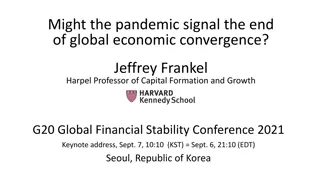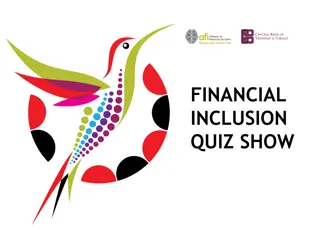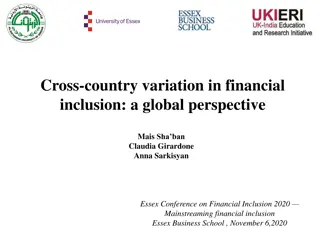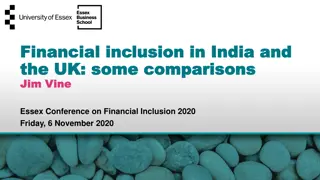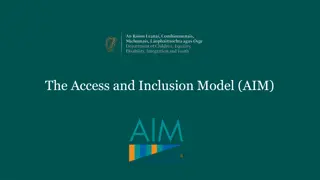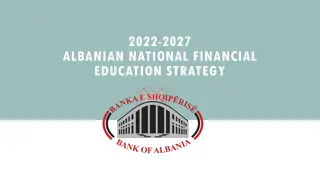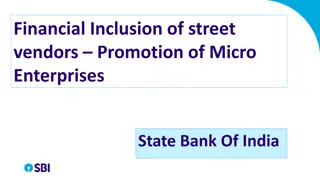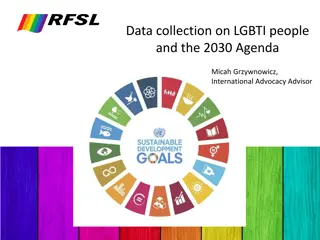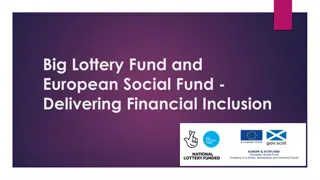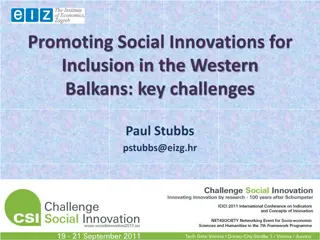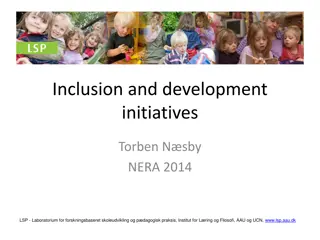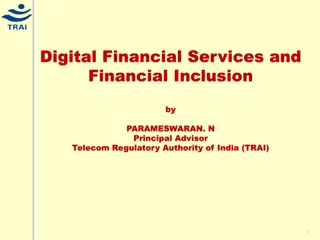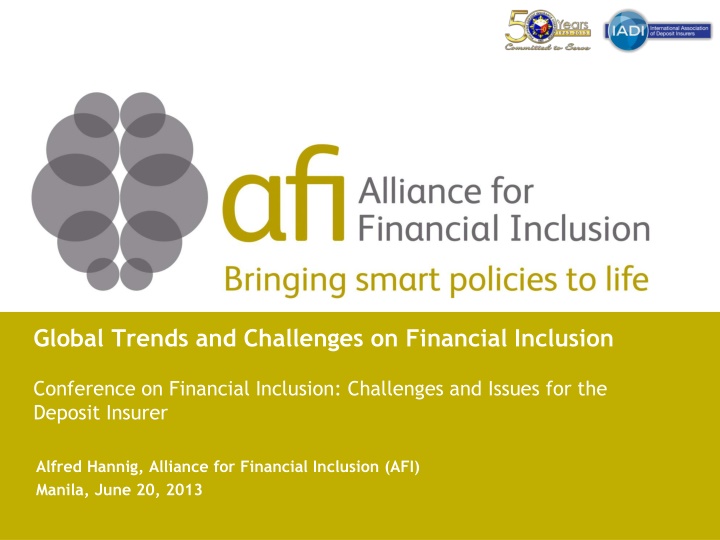
Global Trends and Challenges in Financial Inclusion
A comprehensive overview of the Alliance for Financial Inclusion (AFI), focusing on policies aimed at improving global financial inclusion through innovative solutions. Explore data on unbanked populations, key barriers, and the potential of technology to enhance accessibility to formal financial services.
Download Presentation

Please find below an Image/Link to download the presentation.
The content on the website is provided AS IS for your information and personal use only. It may not be sold, licensed, or shared on other websites without obtaining consent from the author. If you encounter any issues during the download, it is possible that the publisher has removed the file from their server.
You are allowed to download the files provided on this website for personal or commercial use, subject to the condition that they are used lawfully. All files are the property of their respective owners.
The content on the website is provided AS IS for your information and personal use only. It may not be sold, licensed, or shared on other websites without obtaining consent from the author.
E N D
Presentation Transcript
Global Trends and Challenges on Financial Inclusion Conference on Financial Inclusion: Challenges and Issues for the Deposit Insurer Alfred Hannig, Alliance for Financial Inclusion (AFI) Manila, June 20, 2013
Overview of AFI Founded in September 2008, AFI is a global network of policymakers in emerging and developing countries AFI is dedicated to accelerating the adoption of innovative financial inclusion policy solutions with the ultimate aim of making formal financial services more accessible and useable to the billions of unbanked people AFI provides members with the tools and resources to share, develop and implement their knowledge of cutting-edge policies
The Alliance for Financial Inclusion 2008 2012 2009 2010 2011 Activating the Network Enhancing Network value Policy-Driving Network Concept design Building the Network 108 Institutions, 89 countries Unique Peer Learning network (working groups) 7 policy areas More than 35 tangible policy changes Financial Inclusion as mainstream international policy agenda Maya Declaration
Overview Overview of AFI Global Data on Financial Inclusion Trend 1: Financial Inclusion as part of regulators mandate Trend 2: Expansion through innovative use of technology Trend 3: Focus on improving financial inclusion data Trend 4: Focus on quality Trend 5: Redefining Global Standards with SSBs Trend 6: Countries make measurable financial inclusion commitments
Global Data on Financial Inclusion 2.5 billion of adults do not have access to formal financial system Click to edit Master title style Click to edit Master subtitle style Source: World Bank Global Findex. Based on the question: do you have an account at a formal institution
Global Data on Financial Inclusion Global Findex Database with data from 148 countries. Key findings: 2.5 billion of unbanked and that is just an estimate, it could be much higher. Distribution unbanked population (age 15+) per country income Distribution unbanked population (age 15+) per country income Main reported barriers to access are cost of services, physical distance to access points documentation. Data shows potential of technology and innovation to overcome barriers 25% 50% 50% and lack of 17% 6% 3% Banked Low income Upper middle income unbanked Lower middle income High income Huge untapped market Source: World Bank-Findex, CIA yearbook. Based on question: account at a formal institution.
Global Trends and Challenges on Financial Inclusion Trend 1: Financial Inclusion as part of regulators mandate Financial Inclusion is no longer only a development concern but a cornerstone of economic development framework and model; Financial inclusion is a policy goal complementary to stability, integrity and consumer protection; Financial Inclusion is understood in a broad framework including access, usage and quality of a range of financial services. No. of Countries Have dedicated financial inclusion strategy 31 Financial Inclusion is part of institutional mandate 17 22 Created a dedicated financial inclusion unit
Global Trends and Challenges on Financial Inclusion Trend 2: Expansion through innovative use of technology Rationale: technological innovation to reduce cost of delivery and expand access and usage on a large scale Example M-Shwari (Kenya): Interest bearing saving accounts and small loans via mobile phone Account opening and loan disbursement immediately over the phone Cooperation between Safaricom and the Commercial Bank of Africa Credit scoring algorithm based on voice data, payment of phone bills and savings history Total > 10 million USD saved in the first two months
Global Trends and Challenges on Financial Inclusion Number of live mobile money services for the unbanked by region 2001-2012 (year end) Source: http://www.gsma.com/mobilefordevelopment/wp-content/uploads/2013/02/MMU_State_of_industry.pdf
Global Trends and Challenges on Financial Inclusion Trend 3: Focus on improving financial inclusion data AFI Core Set of Financial Inclusion Indicators AFI Second Tier Set of Financial Inclusion Indicators and specific AFI Indicator Sets e.g. MFS, Quality, Pacific Islands FINDEX: First public database that consistently tracks people s use of financial products across countries G20 Global Partnership on Financial Inclusion (GPFI) Subgroup on Data and Measurement
Global Trends and Challenges on Financial Inclusion Trend 4: Focus on quality Rationale: service quality drives usage 50 AFI members call consumer protection a priority area 23 AFI members have made specific commitments related to consumer protection Many countries are undertaking specific programs in financial literacy and financial education G 20 Presidency of Russia emphasizes consumer protection and financial literacy
Global Trends and Challenges on Financial Inclusion Trend 5: Redefining Global Standards While global standards are sufficient to allow proportionate application, they were originally not established with financial inclusion as a consideration; which can lead countries to adopt conservative approaches that limit innovation. Governor Amando Tetangco Jr., Governor of the Central Bank of the Philippines GPFI and HM Queen Maxima have engaged with SSBs on financial inclusion and supported to catalyze the review of existing or formulation of new guidance Annual G-24/AFI Policymakers Roundtable Redefining risk with an extended risk framework A Different Role for SSBs Toward Peer Learning
Global Trends and Challenges on Financial Inclusion Trend 6: Countries make measurable financial inclusion commitments Maya Declaration: The first global and measurable set of commitments on financial inclusion by developing and emerging countries Concrete and measurable individual commitments based on national circumstances Country commitments (Maya Declaration on Financial Inclusion) Financial Inclusion strategy / action plan Enabling environment/ Technology Proportionate regulatory framework Consumer protection and empowerment Evidence-based data Key components of Maya Declaration Knowledge Leadership Cooperation Diversity Innovation Proportionality Framework Protection Empowerment Supporting G20 Principles AFI : Peer learning, Working groups Progress review, Support services Knowledge providers: CGAP, Research institutions Private sector Donors GPFI Others World Bank Group: Financing / TA, Data, etc. DFIs: Investment, TA Partners
Overview of Maya Commitments 39 and growing . Central Asia & Europe Latin America Asia Pacific Africa Bank of the Republic of Burundi Banque Centrale du Congo Central Bank of Ethiopia Bank of Ghana Central Bank of Guinea Central Bank of Kenya Reserve Bank of Malawi Central Bank of Mozambique Bank of Namibia Central Bank of Nigeria National Bank of Rwanda Ministry of Economy and Finance S n gal Bank of Sierra Leone Bank of Tanzania Bank of Uganda Bank of Zambia Banco Central do Brasil Ministry of Social Development Chile Ministr of Finance & Public Credit Colombia Banco Central del Ecuador Banco Central del Reserva & Superintendencia del Sistema Financiero El Salvador (joint commitment) Superintendencia de Bancos Guatemala CNBV Mexico Central Bank of Paraguay SBS Peru Microcredit Regulatory Authority, Bangladesh Bank Indonesia Reserve Bank of Fiji Bank Negara Malaysia Financial Regulatory Commission of Mongolia Central Bank of Pakistan Bank of Papua New Guinea Bangko Sentral ng Pilipinas Central Bank of Samoa Central Bank of Solomon Islands Reserve Bank of Vanuatu Central Bank of the Republic of Armenia National Bank of Belarus Middle East & North Africa Palestine Monetary Authority
IADI and AFI Deposit Insurance directly contributes to financial inclusion by protecting small depositors and indirectly by heightening their trust in the financial system; Potential participation in proposed Peer Learning Program with SSBs and AFI members on extended risk framework (next activity Frankfurt conference on 28 June); Potential cooperation on financial inclusion review of IADI core principles?



